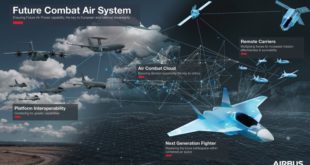Deep sea reach is important to Navies which can collect the information about enemy submarines as well as carry out their own operations undetected. China continues to make progress in deep sea exploration following the three-month mission of a new underwater glider in the South China Sea, which experts said will also help in maritime warfare.
Officials of the U.S. Defense Advanced Research Projects Agency (DARPA) issued a broad agency announcement in Jan 2019 (HR001119S0009) for the Angler project for new capabilities in autonomous exploration and manipulation on the seafloor. U.S. Military researchers are asking the defense industry to develop a deep-diving unmanned underwater vehicle (UUV) and control system able to find and manipulate objects in deep-ocean environments.
Angler seeks to migrate advancements from terrestrial and space-based robotics, terrestrial autonomous manipulation, and underwater sensing technologies into the realm of undersea manipulation, with specific focus on long-distance, seabed-based missions. Specifically, the program aims to discover innovative autonomous robotic solutions capable of navigating unstructured ocean depths, surveying expansive underwater regions, and physically manipulating manmade objects of interest.
Autonomous underwater vehicle
Scientific exploration of the deep sea has traditionally been performed using inhabited submersibles, towed vehicles, and tethered remotely operated vehicles (ROVs) ) – controlled and powered from the surface by an operator/pilot via an umbilical or using remote control.
An autonomous underwater vehicle (AUV) is a robot that travels underwater without requiring input from an operator. Underwater gliders are a subclass of AUVs. In military applications an AUV is more often referred to as an unmanned undersea vehicle (UUV).
Autonomous underwater vehicles (AUVs) have begun to replace ROV vehicles for mapping and survey missions. Autonomous vehicles complement the capabilities of these existing systems, offering superior mapping capabilities, improved logistics, and improved utilization of the surface support vessel.
AUVs are particularly well suited to systematic preplanned surveys using sonars, in situ chemical sensors, and cameras in the rugged deep sea terrain that is the focus of many scientific expeditions. Inhabited submersibles and ROVs remain the only option for manipulation tasks such as sampling, deploying and recovering experiments on the seafloor, detailed inspection, and servicing subsea instruments; however, high resolution maps from AUVs can facilitate these tasks.
Challenges of Deep water Missions
The deep ocean remains one of the most challenging earth-bound domains, despite breakthroughs in terrestrial robotics, space robotics, and underwater sensing, DARPA scientists explain.
While the seafloor often is gently sloping sand dunes, it also has natural and man-made obstacles that complicate search and navigation tasks. Seawater, for example, may be murky enough to complicate perception, search, object recognition, and estimation. Reefs, submarine vents, and fissures can be treacherous, and can change quickly. This represents a major challenge to classical perception techniques, which rely on feature recognition. Man-made objects also may be deteriorated, slippery, partially covered.
Deep-sea missions also require continuous operation over thousands of miles without the aid of Global Positioning System (GPS) localization or human communication or cognition, which imposes substantial autonomy requirements on an already complex system.
Angler Project
Multiple performers will develop an autonomous undersea robot capable of transiting large distances and physically manipulating objects on the seabed with no communications or human intervention.
The DARPA Angler project has two thrusts. First it seeks to develop an autonomous undersea control system that processes mission commands and sensor inputs, understands the seabed and provides control inputs to unmanned vehicles to complete physical manipulation objectives on the seafloor.
Second, the project seeks to design an underwater robot to navigate the seafloor and physically manipulate objects in deep- ocean environments.
Underwater manipulation today typically happens with remotely operated vehicles (ROVs) tethered to a surface vessel, and tele-operated by a human pilot. This can limit their utility because ROVs cannot extend beyond their tethers, and need several operators. Wireless communications for sub-sea teleoperations, moreover, largely is impractical because seawater attenuates electromagnetic wave propagation and available bandwidth. For these reasons, underwater manipulation is difficult enough using teleoperation with the aid of human operators; it’s even harder with vision systems and machine autonomy mixed-in.
Instead, DARPA researchers want industry to develop the Angler robotic system capable of long-distance underwater manipulation missions. It will operate autonomously and without external communication to navigate, search, localize, and physically manipulate objects on or near the seabed, using onboard sensors to self-localize, avoid obstacles, interact with the seabed, and manipulate objects. It also will be able to search for and manipulate deep undersea objects in dark or murky water.
The Angler program will fit an underwater robot with autonomy and control for several physical manipulation objectives in one long mission without human intervention. Proposers should focus on autonomy and decision support algorithm technologies to identify challenging objects and plan grasp those objects.
Chief enabling technologies for this project will involve manipulation and autonomy in underwater robotics, DARPA researchers say. The program aims to discover autonomous robotic solutions in sensing techniques for high-resolution navigation in GPS-deprived underwater environments; perception and manipulation for grasping degraded and malformed manmade objects; long-duration autonomy; and mission planning without human intervention. Eventually these technologies may move to an operational military system.
DARPA scientists want proposers to capitalize on existing hardware, software, simulation infrastructure, and physical interfaces as much as possible. Capabilities of interest include long-duration machine autonomy; information fusion; object recognition; autonomous grasp planning; dynamic station keeping at or near the seabed; and sustained sprint capabilities to evade obstacles and traffic.
References and Resources also include:
https://www.darpa.mil/news-events/angler-proposers-day
https://www.militaryaerospace.com/articles/2019/01/unmanned-deep-sea-machine-autonomy.html
 International Defense Security & Technology Your trusted Source for News, Research and Analysis
International Defense Security & Technology Your trusted Source for News, Research and Analysis

